Exploring the Multidimensional Visual Perception of Urban Riverfront Street Environments: A Framework Using Street View Images, Deep Learning and Eye-Tracking
Abstract
1. Introduction
2. Materials and Methods
2.1. Research Framework
2.2. Study Area
2.3. Data Collection and Process
2.3.1. Extracting URS Landscape Elements
2.3.2. Scoring Landscape Elements’ Visual Attention
2.3.3. Scoring AP and DE Perception
3. Results
3.1. Spatial Distribution of Landscape Elements
3.2. Analysis of the Visual Attention of the URS Landscape
3.2.1. EVA Value
3.2.2. Visual Attention Evaluation Model Construction
3.3. Coupling Analysis of AP and DE Perception
3.3.1. Influence of Landscape Elements on Aesthetic Preference and Distinctiveness Perception
3.3.2. Construction of Aesthetic Preference and Distinctiveness Perception Evaluation Models
4. Discussion
4.1. Comprehensive Evaluation of Visual Perception of URSs
4.2. Influence Mechanism of Landscape Elements on VA, AP, and DE
4.3. Limitations
5. Conclusions
Author Contributions
Funding
Institutional Review Board Statement
Informed Consent Statement
Data Availability Statement
Conflicts of Interest
References
- Li, X.; Wang, X.; Jiang, X.; Han, J.; Wang, Z.; Wu, D.; Lin, Q.; Li, L.; Zhang, S.; Dong, Y. Prediction of riverside greenway landscape aesthetic quality of urban canalized rivers using environmental modeling. J. Clean. Prod. 2022, 367, 133066. [Google Scholar] [CrossRef]
- Sairinen, R.; Kumpulainen, S. Assessing social impacts in urban waterfront regeneration. Environ. Impact Assess. Rev. 2006, 26, 120–135. [Google Scholar] [CrossRef]
- Yao, Y.M.; Zhu, X.D.; Xu, Y.B.; Yang, H.Y.; Sun, X. Assessing the Visual Quality of Urban Waterfront Landscapes: The Case of Hefei, China. Acta Ecol. Sin. 2012, 32, 5836–5845. [Google Scholar] [CrossRef]
- Kwiatkowski, M.A.; Karbowiński, Ł. Why the Riverside Is an Attractive Urban Corridor for Bicycle Transport and Recreation. Cities 2023, 143, 104611. [Google Scholar] [CrossRef]
- Kang, N.; Liu, C. Towards Landscape Visual Quality Evaluation: Methodologies, Technologies, and Recommendations. Ecol. Indic. 2022, 142, 109174. [Google Scholar] [CrossRef]
- Zhou, X.; Cen, Q.; Qiu, H. Effects of Urban Waterfront Park Landscape Elements on Visual Behavior and Public Preference: Evidence from Eye-Tracking Experiments. Urban For. Urban Green. 2023, 82, 127889. [Google Scholar] [CrossRef]
- Erkök, F. Waterfront: Potentials for Improving the Quality of Urban Life. Istanb. Tech. Univ. Fac. Archit. 2009, 6, 126–145. [Google Scholar]
- Wu, J.; Li, J.W.; Ma, Y. Exploring the Relationship between Potential and Actual of Urban Waterfront Spaces in Wuhan Based on Social Network. Sustainability 2019, 11, 3298. [Google Scholar] [CrossRef]
- Breen, A.; Rigby, D. Waterfronts: Cities Reclaim Their Edge; McGraw-Hill Inc.: New York, NY, USA, 1994. [Google Scholar]
- Pramesti, R.E. Sustainable Urban Waterfront Redevelopment: Challenge and Key Issues. Media Matrasain 2017, 14, 41–54. [Google Scholar]
- Liu, S.; Lai, S.Q. Research on Urban Waterfront Public Space Satisfaction Evaluation Based on AHP-IPA Method. Urban Archit. 2024, 21, 73–79. [Google Scholar] [CrossRef]
- Liu, Y.; Sun, X. Evaluation of Public Facility Service Functions in Urban Waterfront Parks: A Case Study of Yueya Lake Park in Nanjing. Gardening 2021, 38, 57–65. [Google Scholar]
- Yang, C.; Shao, B. The Influence of Waterfront Public Space Elements on Retention Vitality and Countermeasures: A Case Study of Two Typical Waterfront Areas in Shanghai’s Huangpu River. Urban Archit. 2018, 5, 40–47. [Google Scholar] [CrossRef]
- Zhang, J.; Yu, Q.Q.; Fu, D.S.; Zhang, C.; Guo, T.T.; Xin, Y.; Shao, F. Research on Urban Waterfront Space Vitality Based on Multi-Source Data: A Case Study of Hangzhou West Lake Waterfront Area. Zhejiang For. Sci. Technol. 2023, 43, 82–89. [Google Scholar]
- Zeng, X.; Zhang, Z. Urban Waterfront Landscape Planning and Design Based on Regional Ecology Priority: A Case Study of the Grass Street Riverside Landscape Planning on Jialing River, Chongqing. Chin. Landsc. Archit. 2010, 26, 49–53. [Google Scholar]
- Bulut, Z.; Yilmaz, H. Determination of Waterscape Beauties through Visual Quality Assessment Method. Environ. Monit. Assess. 2009, 154, 459–468. [Google Scholar] [CrossRef]
- Liu, B. Towards Landscape Interaction: Inheritance and Development of Landscape Perception and Visual Evaluation. Landsc. Archit. 2022, 29, 12–17. [Google Scholar] [CrossRef]
- Filova, L.; Vojar, J.; Svobodova, K.; Sklenicka, P. The Effect of Landscape Type and Landscape Elements on Public Visual Preferences: Ways to Use Knowledge in the Context of Landscape Planning. J. Environ. Plan. Manag. 2015, 58, 2037–2055. [Google Scholar] [CrossRef]
- Misthos, L.-M.; Krassanakis, V.; Merlemis, N.; Kesidis, A.L. Modeling the Visual Landscape: A Review on Approaches, Methods and Techniques. Sensors 2023, 23, 8135. [Google Scholar] [CrossRef] [PubMed]
- Wei, J.; Yue, W.; Li, M.; Gao, J. Mapping Human Perception of Urban Landscape from Street-View Images: A Deep-Learning Approach. Int. J. Appl. Earth Obs. Geoinf. 2022, 112, 102886. [Google Scholar] [CrossRef]
- Dubey, A.; Naik, N.; Parikh, D.; Raskar, R.; Hidalgo, C.A. Deep Learning the City: Quantifying Urban Perception at a Global Scale; Springer International Publishing: Cham, Switzerland, 2016; pp. 196–212. [Google Scholar] [CrossRef]
- Poledniková, Z.; Galia, T. Photo Simulation of a River Restoration: Relationships between Public Perception and Ecosystem Services. River Res. Appl. 2021, 37, 44–53. [Google Scholar] [CrossRef]
- Ding, J.; Luo, L.; Shen, X.; Xu, Y. Influence of Built Environment and User Experience on the Waterfront Vitality of Historical Urban Areas: A Case Study of the Qinhuai River in Nanjing, China. Front. Archit. Res. 2023, 12, 820–836. [Google Scholar] [CrossRef]
- Lan, W.J.; Wang, L.L. Research on Conservation Methods for Diversified Characteristic Blocks from the Perspective of Historic Urban Landscapes: A Case Study of the Yu Liang Nan Road Historic and Cultural Block in Jiujiang. China Famous Cities 2019, 4, 71–77. [Google Scholar] [CrossRef]
- Daniel, T.; Boster, R. Measuring Landscape Esthetics: The Aesthetic Preference Estimation Method; US Forest Service: Washington, DC, USA, 1976. [Google Scholar]
- Yazici, K.; Asur, F. Assessment of Landscape Types and Aesthetic Qualities by Visual Preferences (Tokat, Turkey). 2021. Available online: https://avesis.yyu.edu.tr/yayin/d137a2d7-f81d-4cd4-a703-1d02daf0544d/assessment-of-landscape-types-and-aesthetic-qualities-by-visual-preferences-tokat-turkey (accessed on 15 September 2025).
- Akten, M.; Celik, M. Evaluation of Visual Landscape Perception for Incilipinar and Adalet Park Cases. J. Food Agric. Environ. 2013, 11, 1532–1538. [Google Scholar]
- Chen, Y.; Zhong, Q.; Li, B. Positive or Negative Viewpoint Determines the Overall Scenic Beauty of a Scene: A Landscape Perception Evaluation Based on a Panoramic View. Sustainability 2023, 15, 11458. [Google Scholar] [CrossRef]
- Zhang, F.; Zhou, B.; Liu, L.; Liu, Y.; Fung, H.H.; Lin, H.; Ratti, C. Measuring Human Perceptions of a Large-Scale Urban Region Using Machine Learning. Landsc. Urban Plan. 2018, 180, 148–160. [Google Scholar] [CrossRef]
- Huang, J.; Obracht-Prondzynska, H.; Kamrowska-Zaluska, D.; Sun, Y.; Li, L. The Image of the City on Social Media: A Comparative Study Using ‘Big Data’ and ‘Small Data’ Methods in the Tri-City Region in Poland. Landsc. Urban Plan. 2021, 206, 103977. [Google Scholar] [CrossRef]
- Filomena, G.; Verstegen, J.A.; Manley, E. A Computational Approach to ‘The Image of the City’. Cities 2019, 89, 14–25. [Google Scholar] [CrossRef]
- De Lucio, J.V.; Mohamadian, M.; Ruiz, J.; Banayas, J.; Bernaldez, F. Visual Landscape Exploration as Revealed by Eye Movement Tracking. Landsc. Urban Plan. 1996, 34, 135–142. [Google Scholar] [CrossRef]
- Carrasco, M.; Eckstein, M.; Verghese, P.; Boynton, G.; Treue, S. Visual Attention: Neurophysiology, Psychophysics, and Cognitive Neuroscience. Vis. Res. 2009, 49, 1033–1036. [Google Scholar] [CrossRef][Green Version]
- Zhang, X.; Xiong, X.; Chi, M.; Yang, S.; Liu, L. Research on Visual Quality Assessment and Landscape Elements Influence Mechanism of Rural Greenways. Ecol. Indic. 2024, 160, 111844. [Google Scholar] [CrossRef]
- Qin, X.; Fang, M.; Yang, D.; Wangari, V.W. Quantitative Evaluation of Attraction Intensity of Highway Landscape Visual Elements Based on Dynamic Perception. Environ. Impact Assess. Rev. 2023, 100, 107081. [Google Scholar] [CrossRef]
- Zhang, Y.; Xiong, X.; Yang, S.; Zhang, Q.; Chi, M.; Wen, X.; Zhang, X.; Wang, J.; Mejjad, N. Enhancing the Visual Environment of Urban Coastal Roads through Deep Learning Analysis of Street-View Images: A Perspective of Aesthetic and Distinctiveness. PLoS ONE 2025, 20, e0317585. [Google Scholar] [CrossRef] [PubMed]
- Qiu, Y.; Luo, T.; Wang, Y.Y.; Fang, X.L.; Zhao, C. Research on the Perceptual Characteristics of Urban Landscape Elements Based on Visual Attention and Aesthetic Preference. Chin. Landsc. Archit. 2023, 39, 82–87. [Google Scholar] [CrossRef]
- Jiang, X.; Li, X.; Wang, M.; Zhang, X.; Zhang, W.; Li, Y.; Cong, X.; Zhang, Q. Multidimensional Visual Preferences and Sustainable Management of Heritage Canal Waterfront Landscape Based on Panoramic Image Interpretation. Land 2025, 14, 220. [Google Scholar] [CrossRef]
- Luo, S.; Xie, J.; Furuya, K. Effects of Perceived Physical and Aesthetic Quality of Urban Blue Spaces on User Preferences: A Case Study of Three Urban Blue Spaces in Japan. Heliyon 2023, 9, e15033. [Google Scholar] [CrossRef]
- Jiang, H.; Song, M.K.; Xiao, Y. Study on the Visual Comfort Evaluation of Waterfront Spaces: A Case Study of ‘One River and One Creek’ in Shanghai. Landsc. Archit. 2022, 29, 122–129. [Google Scholar]
- Truong, T.L.H.; Lenglet, F.; Mothe, C. Destination distinctiveness: Concept, measurement, and impact on tourist satisfaction. J. Destin. Mark. Manag. 2018, 8, 214–231. [Google Scholar] [CrossRef]
- Wu, Y.F.; Rong, X. The Relationship between Suzhou’s Waterfront Street Distribution and Urban Changes in the Ming and Qing Dynasties. City Plan. Rev. 2017, 41, 96–100. [Google Scholar]
- Zhang, L.; Pei, T.; Wang, X.; Wu, M.; Song, C.; Guo, S.; Chen, Y. Quantifying the urban visual perception of Chinese traditional-style building with street view images. Appl. Sci. 2020, 10, 5963. [Google Scholar] [CrossRef]
- Ogawa, Y.; Oki, T.; Zhao, C.; Sekimoto, Y.; Shimizu, C. Evaluating the Subjective Perceptions of Streetscapes Using Street-View Images. Landsc. Urban Plan. 2024, 247, 105073. [Google Scholar] [CrossRef]
- Ma, R.; Luo, Y.; Furuya, K. Classifying Visually Appealing Elements in Parks Using Social Media Data-Assisted Eye-Tracking: Case Study of Shinsui Parks in Tokyo, Japan. J. Outdoor Recreat. Tour. 2023, 44, 100672. [Google Scholar] [CrossRef]
- Yuan, Y.; Wang, L.; Wu, W.; Zhong, S.; Wang, M. Locally Contextualized Psycho-Physiological Wellbeing Effects of Environmental Exposures: An Experimental-Based Evidence. Urban For. Urban Green. 2023, 88, 128070. [Google Scholar] [CrossRef]
- Naghibi, M. Rethinking Small Vacant Lands in Urban Resilience: Decoding Cognitive and Emotional Responses to Cityscapes. Cities 2024, 151, 105167. [Google Scholar] [CrossRef]
- Li, C.; Huang, X. Differences in Visual Attraction between Historical Garden and Urban Park Walking Scenes. Land 2022, 11, 1766. [Google Scholar] [CrossRef]
- Airas, A.; Hall, P.V.; Stern, P. Asserting Historical ‘Distinctiveness’ in Industrial Waterfront Transformation. Cities 2015, 44, 86–93. [Google Scholar] [CrossRef]

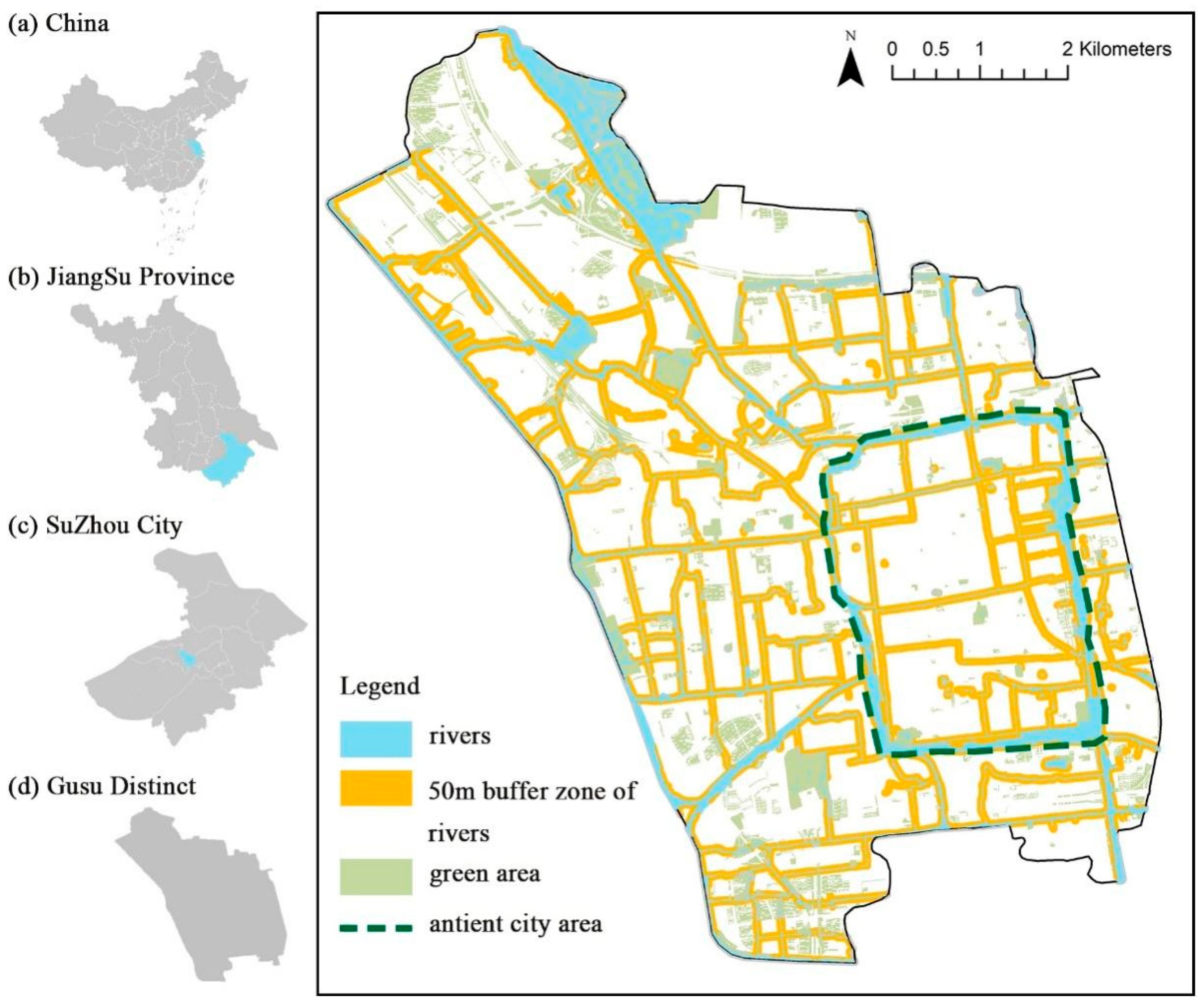
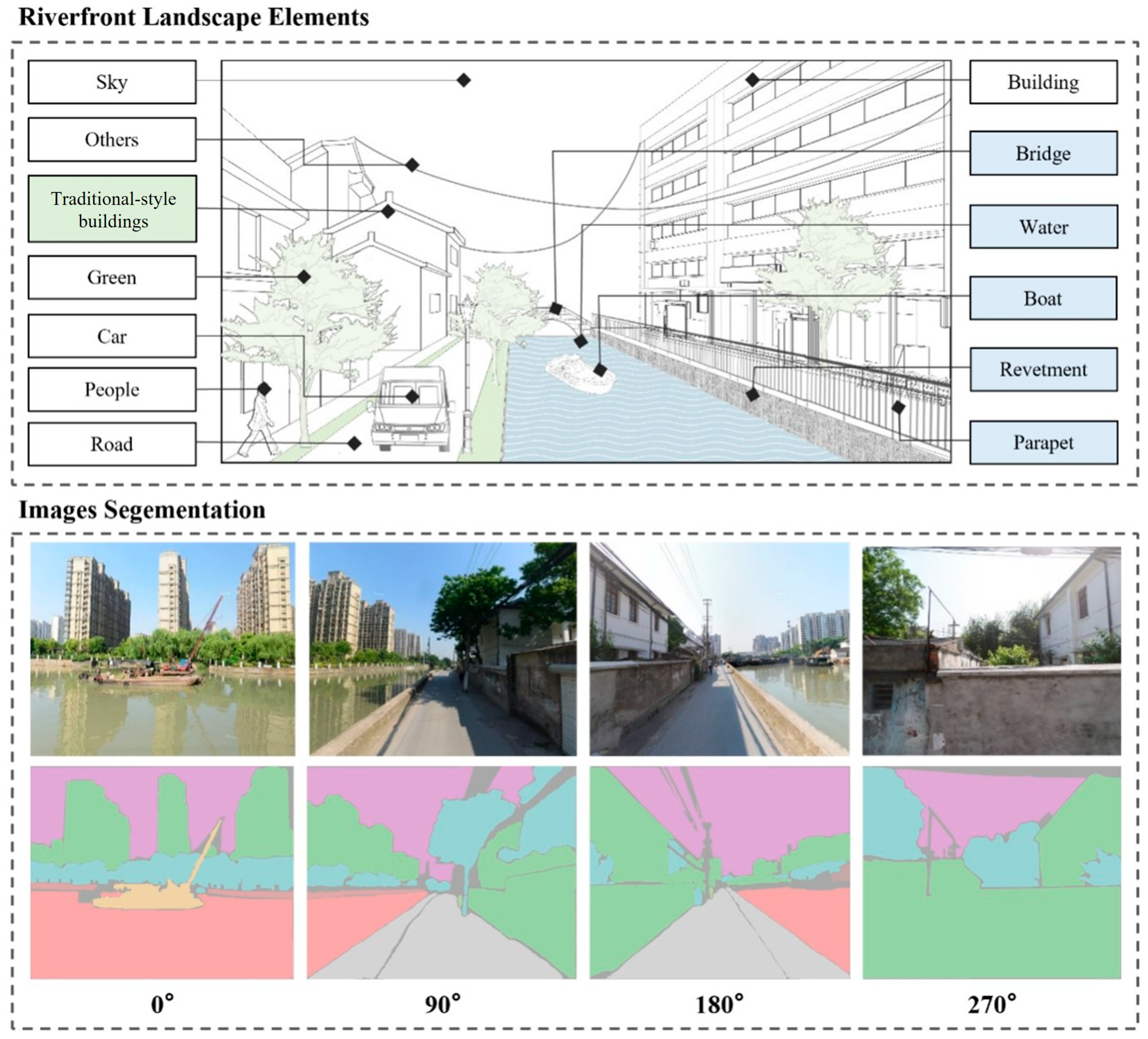

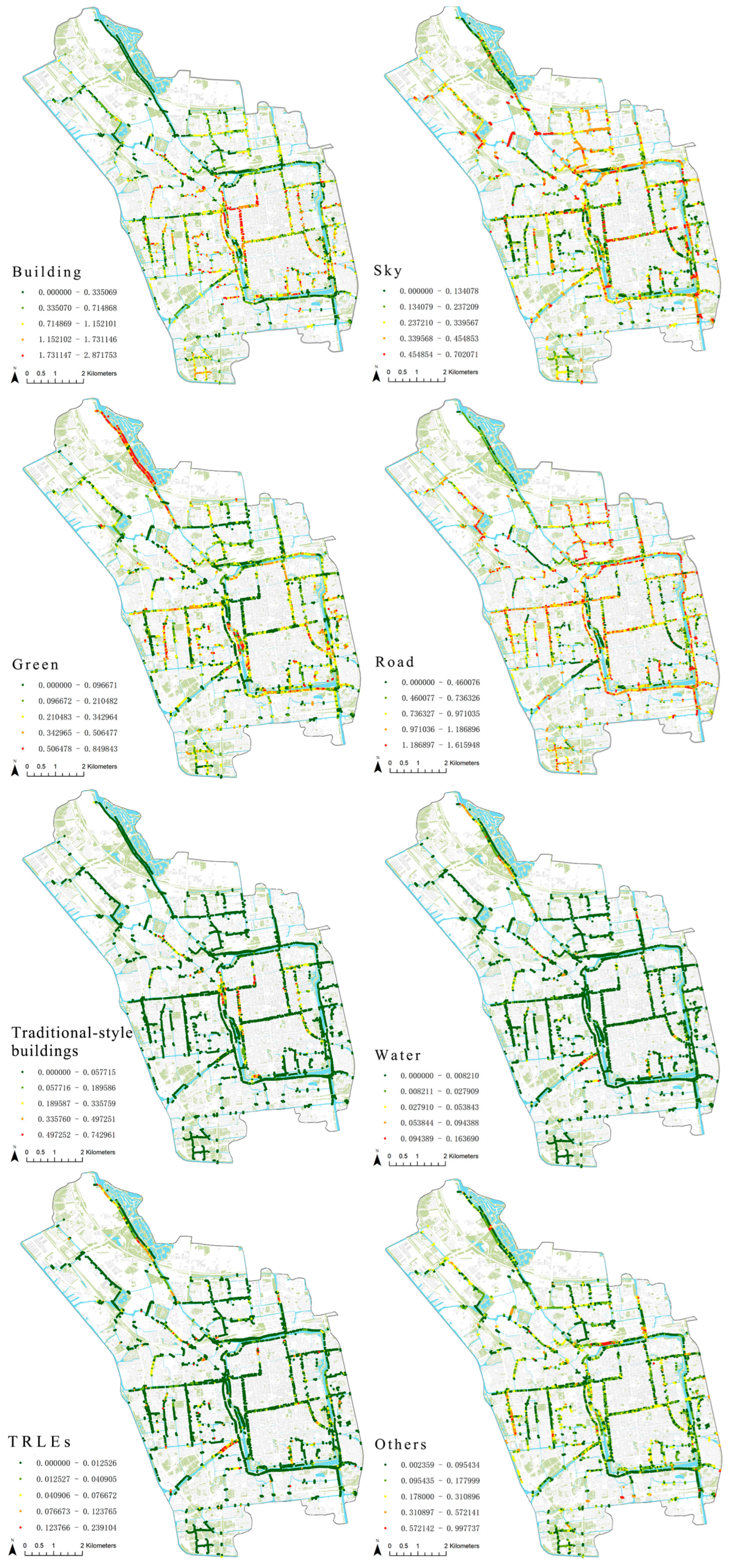



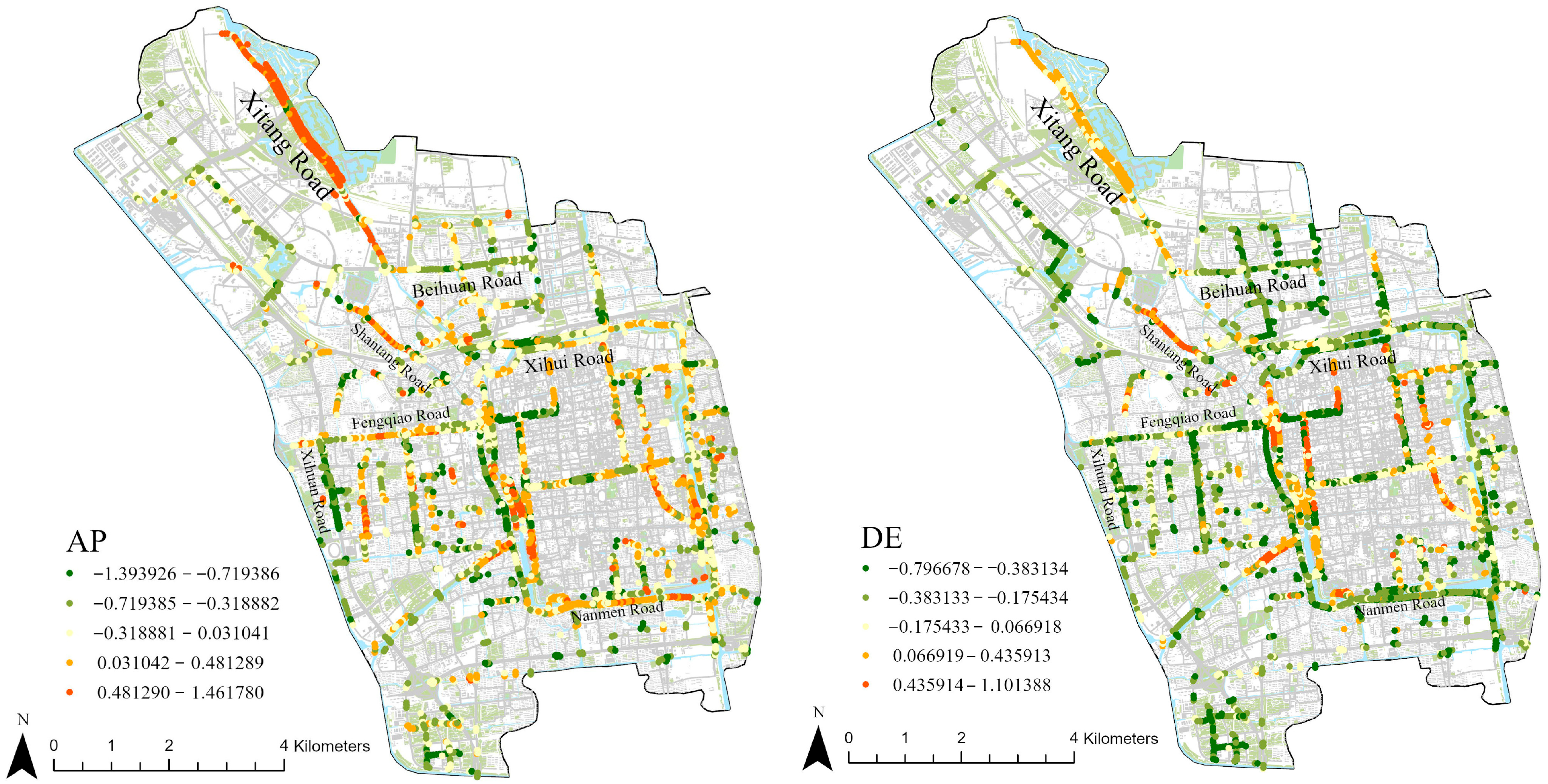
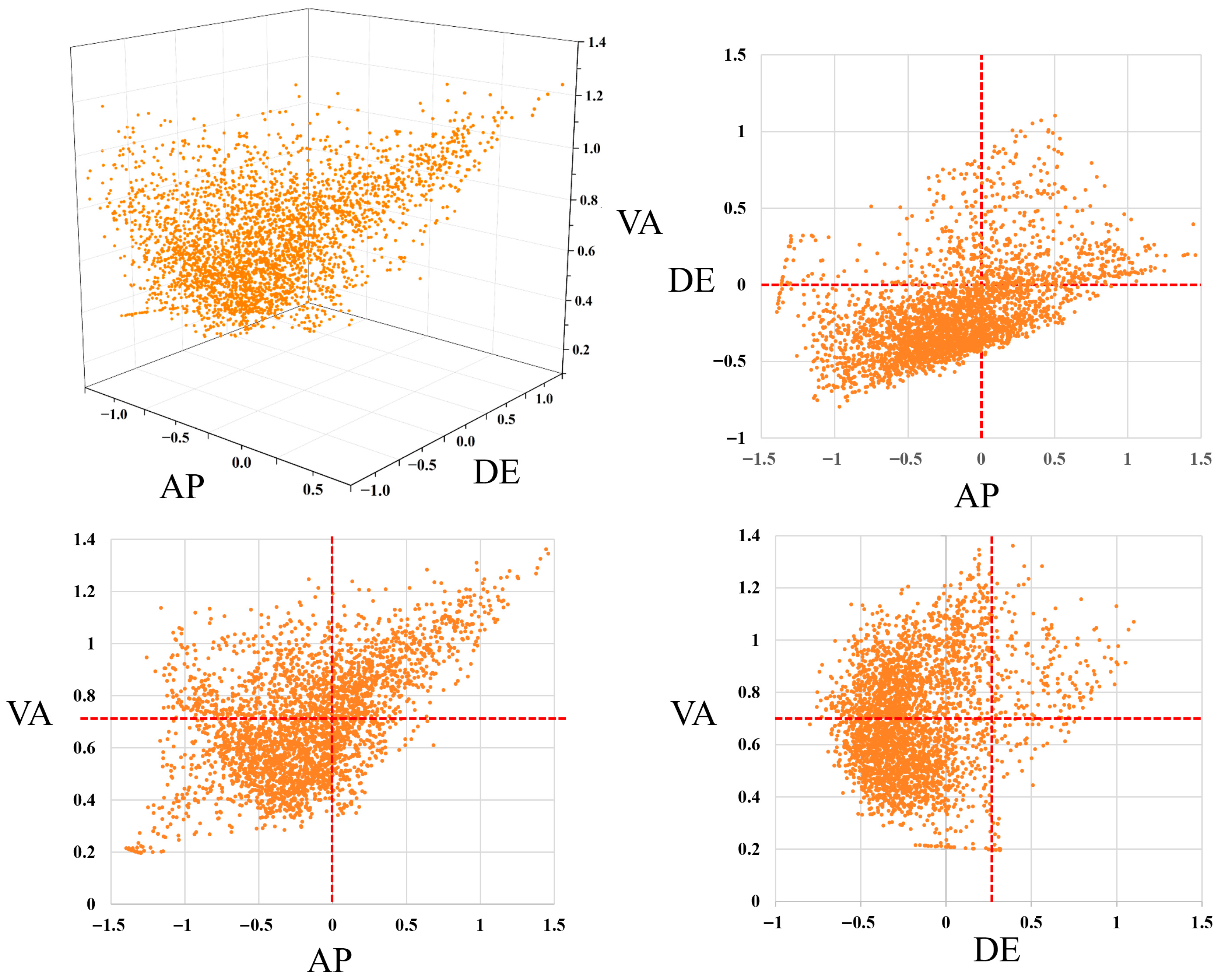
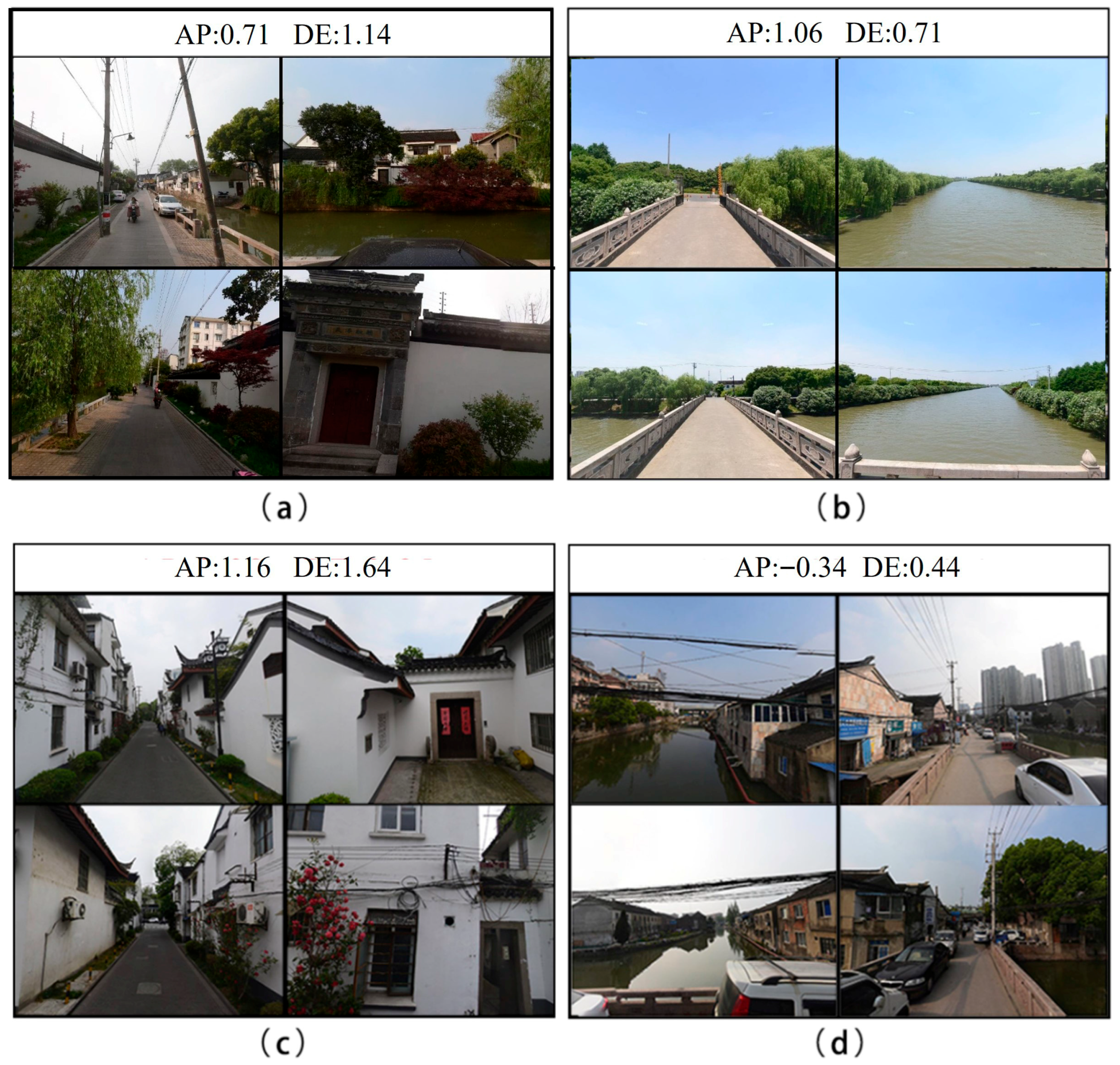

| Buildings | Sky | Green | Roads | Traditional-Style Buildings | Water | TRLEs | Others |
|---|---|---|---|---|---|---|---|
| 13.75% | 27.94% | 19.49% | 20.45% | 2.65% | 0.47% | 0.54% | 14.71% |
| Element | Percent (Element) | EVA (Element) | Element | Percent (Element) | EVA (Element) |
|---|---|---|---|---|---|
| Buildings | 11.37% | 1.38 | Traditional-style buildings | 6.65% | 1.19 |
| Sky | 28.16% | 0.26 | Water | 1.71% | 1.4 |
| Green | 20.95% | 1.53 | TRLEs | 1.25% | 1.81 |
| Roads | 17.26% | 0.28 | Others | 12.64% | 0.19 |
| Image Number | AP | DE | Image Number | AP | DE |
|---|---|---|---|---|---|
| sample_1 | 0.65 | −0.13 | sample_25 | 0.37 | 1.03 |
| sample_2 | 0.27 | −0.05 | sample_26 | 0.26 | 0.90 |
| sample_3 | −0.11 | −0.37 | sample_27 | 0.65 | 0.97 |
| sample_4 | 0.37 | −0.17 | sample_28 | −0.95 | −0.54 |
| sample_5 | −0.51 | −0.76 | sample_29 | 0.82 | −0.23 |
| sample_6 | 0.02 | 0.04 | sample_30 | −0.48 | −0.59 |
| sample_7 | 0.65 | −0.10 | sample_31 | 0.48 | 1.09 |
| sample_8 | −0.03 | −0.54 | sample_32 | 0.84 | 0.30 |
| sample_9 | 0.10 | −0.27 | sample_33 | −0.73 | −0.62 |
| sample_10 | 0.56 | 0.13 | sample_34 | −0.86 | −0.70 |
| sample_11 | −1.29 | −0.79 | sample_35 | −0.85 | −0.26 |
| sample_12 | −0.91 | −0.57 | sample_36 | 0.52 | 0.16 |
| sample_13 | −1.19 | −0.90 | sample_37 | −0.68 | −0.81 |
| sample_14 | 0.03 | 0.34 | sample_38 | 0.61 | 0.55 |
| sample_15 | −0.59 | 0.16 | sample_39 | −0.40 | −0.63 |
| sample_16 | 0.48 | 0.10 | sample_40 | −1.03 | −0.60 |
| sample_17 | 0.71 | 1.14 | sample_41 | 1.06 | 0.71 |
| sample_18 | 0.23 | 0.69 | sample_42 | 1.33 | −0.02 |
| sample_19 | 1.16 | 1.64 | sample_43 | −0.56 | −0.66 |
| sample_20 | 0.10 | 0.01 | sample_44 | 0.11 | 0.18 |
| sample_21 | 0.08 | −0.29 | sample_45 | −0.33 | −0.52 |
| sample_22 | −0.24 | 0.41 | sample_46 | −0.05 | −0.50 |
| sample_23 | −0.45 | 0.13 | sample_47 | 0.18 | 0.07 |
| sample_24 | −0.09 | 0.44 | sample_48 | −0.34 | 0.44 |
| AP | DE | TRLEs | Others | Buildings | Sky | Green | Roads | Traditional-Style Buildings | Water | |
|---|---|---|---|---|---|---|---|---|---|---|
| AP | 1 | |||||||||
| DE | 0.679 ** | 1 | ||||||||
| TRLEs | 0.095 | 0.306 * | 1 | |||||||
| others | −0.320 * | −0.123 | 0.004 | 1 | ||||||
| buildings | −0.521 ** | −0.374 ** | −0.083 | −0.048 | 1 | |||||
| sky | 0.117 | 0.082 | 0.033 | −0.275 | −0.143 | 1 | ||||
| green | 0.575 ** | 0.071 | −0.022 | −0.224 | −0.337 * | −0.405 ** | 1 | |||
| roads | −0.382 ** | −0.513 ** | −0.451 ** | −0.185 | 0.234 | −0.09 | −0.146 | 1 | ||
| traditional-style buildings | 0.003 | 0.399 ** | −0.025 | −0.071 | −0.357 * | −0.159 | −0.264 | −0.19 | 1 | |
| water | 0.245 | 0.412 ** | 0.640 ** | 0.085 | −0.112 | 0.009 | −0.07 | −0.468 ** | 0.015 | 1 |
| Model | Unstandardized Coefficients | Standardized Coefficients | t | Sig. | Collinearity Statistics | |||
|---|---|---|---|---|---|---|---|---|
| B | Std. Error | Beta | Tolerance | VIF | ||||
| 1 | (Constant) | 0.581 | 0.221 | 2.636 | 0.012 | |||
| Others | −1.877 | 0.603 | −0.318 | −3.110 | 0.003 | 0.893 | 1.119 | |
| Buildings | −1.836 | 0.556 | −0.347 | −3.300 | 0.002 | 0.844 | 1.185 | |
| Green | 1.238 | 0.387 | 0.342 | 3.198 | 0.003 | 0.816 | 1.226 | |
| Roads | −2.287 | 0.753 | −0.309 | −3.036 | 0.004 | 0.900 | 1.111 | |
| 2 | (Constant) | 0.315 | 0.210 | 1.498 | 0.142 | |||
| Buildings | −0.875 | 0.620 | −0.177 | −1.412 | 0.165 | 0.843 | 1.186 | |
| Roads | −2.113 | 0.931 | −0.305 | −2.271 | 0.028 | 0.732 | 1.367 | |
| Water | 4.109 | 2.180 | 0.246 | 1.885 | 0.066 | 0.774 | 1.291 | |
| Traditional-style buildings | 1.193 | 0.542 | 0.274 | 2.202 | 0.033 | 0.853 | 1.172 | |
| AP | DE | VA | |
|---|---|---|---|
| AP | 1 | 0.506 ** | 0.515 ** |
| DE | 1 | 0.222 ** | |
| VA | 1 |
| Landscape Elements | VA | AP | DE | Type |
|---|---|---|---|---|
| Buildings | 1.12 | −1.84 | −0.88 | − |
| Sky | 0 | 0 | 0 | · |
| Green | 1.27 | 1.24 | 0 | + |
| Roads | 0.02 | −2.29 | −2.11 | - |
| Traditional-style buildings | 0.93 | 0 | 1.19 | + |
| Water | 1.14 | 0 | 4.11 | + |
| TRLEs | 1.55 | 0 | 0 | · |
| Others | −0.07 | −1.88 | 0 | − |
Disclaimer/Publisher’s Note: The statements, opinions and data contained in all publications are solely those of the individual author(s) and contributor(s) and not of MDPI and/or the editor(s). MDPI and/or the editor(s) disclaim responsibility for any injury to people or property resulting from any ideas, methods, instructions or products referred to in the content. |
© 2025 by the authors. Licensee MDPI, Basel, Switzerland. This article is an open access article distributed under the terms and conditions of the Creative Commons Attribution (CC BY) license (https://creativecommons.org/licenses/by/4.0/).
Share and Cite
Xiong, X.; Wu, Y.; Ma, M.; Yang, S.; Zhang, J.; Zhang, Q.; Ye, H.; Hu, Y. Exploring the Multidimensional Visual Perception of Urban Riverfront Street Environments: A Framework Using Street View Images, Deep Learning and Eye-Tracking. Land 2025, 14, 2039. https://doi.org/10.3390/land14102039
Xiong X, Wu Y, Ma M, Yang S, Zhang J, Zhang Q, Ye H, Hu Y. Exploring the Multidimensional Visual Perception of Urban Riverfront Street Environments: A Framework Using Street View Images, Deep Learning and Eye-Tracking. Land. 2025; 14(10):2039. https://doi.org/10.3390/land14102039
Chicago/Turabian StyleXiong, Xing, Yifan Wu, Miaomiao Ma, Shanrui Yang, Junxiang Zhang, Qinghai Zhang, Haiyue Ye, and Yuanke Hu. 2025. "Exploring the Multidimensional Visual Perception of Urban Riverfront Street Environments: A Framework Using Street View Images, Deep Learning and Eye-Tracking" Land 14, no. 10: 2039. https://doi.org/10.3390/land14102039
APA StyleXiong, X., Wu, Y., Ma, M., Yang, S., Zhang, J., Zhang, Q., Ye, H., & Hu, Y. (2025). Exploring the Multidimensional Visual Perception of Urban Riverfront Street Environments: A Framework Using Street View Images, Deep Learning and Eye-Tracking. Land, 14(10), 2039. https://doi.org/10.3390/land14102039






